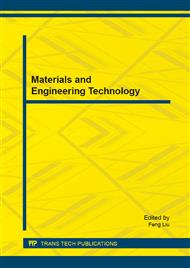[1]
W. Weber, III, Differential encoding for multiple amplitude and phase shift keying systems, IEEE Trans. Commun., vol. 26, pp.385-391, Mar. (1978).
DOI: 10.1109/tcom.1978.1094074
Google Scholar
[2]
D. Warrier and U. Madhow, Spectrally efficient noncoherent com- munication, IEEE Trans. Inf. Theory, vol. 48, no. 3, pp.651-668, Mar. (2002).
DOI: 10.1109/18.985996
Google Scholar
[3]
W. T. Webb, L. Hanzo, and R. Steele, Bandwidth efficient QAM schemes for Rayleigh fading channels, in Proc. IEE Communications, Speech and Vision, vol. 138, pp.169-175, June (1991).
DOI: 10.1049/ip-i-2.1991.0023
Google Scholar
[4]
R. Fischer, L. Lampe, and S. Calabro, Differential encoding strategies for transmission over fading channels, Int. J. Elect. Commun., pp.59-67, Jan. (2000).
Google Scholar
[5]
N. Jacobsen and U. Madhow, Coded noncoherent communication with amplitude/phase modulation: from Shannon theory to practical architectures, IEEE Trans. Commun., vol. 56, no. 12, pp.2040-2048, Dec. (2008).
DOI: 10.1109/tcomm.2008.040684
Google Scholar
[6]
D. Liang, S. X. Ng, and L. Hanzo, Soft-decision star-QAM aided BICM-ID, IEEE Signal Process. Lett., vol. 18, no. 2, pp.169-172, Mar. (2011).
DOI: 10.1109/lsp.2011.2104951
Google Scholar
[7]
L. Wang and L. Hanzo, Low-complexity near-optimum multiple-symbol differential detection of DAPSK based on iterative amplitude/phase processing, IEEE Trans. Veh. Technol., vol. 61, no. 2, pp.894-900, Feb. (2012).
DOI: 10.1109/tvt.2011.2181192
Google Scholar
[8]
P. A. Bello and B. D. Nelin, The influence of fading spectrum on the binary error probabilities of incoherent and differentially coherent matched filter receivers, IRE Trans. Commun. Sys., vol. CS-10, pp.160-168, June (1962).
DOI: 10.1109/tcom.1962.1088654
Google Scholar
[9]
Y. M. Chen and Y. L. Ueng, Differential amplitude/phase modula- tion for correlated Rayleigh fading channels: performance analysis and labelling design, submitted to IEEE Trans. Commun. (Revised).
DOI: 10.1109/tcomm.2014.2338867
Google Scholar
[10]
S. ten Brink, Convergence behavior of iteratively decoded parallel concatenated codes, IEEE Trans. Commun., vol. 49, no. 10, pp.1727-1737, Oct. (2001).
DOI: 10.1109/26.957394
Google Scholar
[11]
A. Ashikhmin, G. Kramer, and S. ten Brink, Design of low-density parity-check codes for modulation and detection, IEEE Trans. Commun., vol. 52, no. 4, pp.670-678, Apr. (2004).
DOI: 10.1109/tcomm.2004.826370
Google Scholar
[12]
Y. M. Chen, Y. L. Ueng, and H. J. Shiau, An EXIT-based design method for LDPC coded schemes without Gaussian assumptions, IEEE Commun. Lett., vol. 17, no. 8, pp.1648-1651, Aug. (2013).
DOI: 10.1109/lcomm.2013.052413.130979
Google Scholar
[13]
R. Y. Wei, Differential encoding by a look-up table for quadrature- amplitude modulation, IEEE Trans. Commun., vol. 59, pp.84-94, Jan. (2011).
DOI: 10.1109/tcomm.2010.102910.100061
Google Scholar
[14]
W. C. Jakes, Jr., Ed., Microwave Mobile Communications. New York: Wiley, (1974).
Google Scholar
[15]
C. Xiao, A generalized simulation model for Rayleigh fading channels with accurate second-order statistics, in Proc. IEEE VTC2002-Spring, Birmingham, Al, May 6-9, (2002).
DOI: 10.1109/vtc.2002.1002686
Google Scholar
[16]
P. Ho and D. Fung, Error performance of multiple symbol differential detection of PSK signals transmitted over correlated Rayleigh fading channels, in Proc. IEEE ICC1991, 23-26 June (1991).
DOI: 10.1109/icc.1991.162428
Google Scholar
[17]
F. Kschinschang, B. Frey and H. -A. Loeliger. Factor graphs and the sum-product algorithm, IEEE Trans. Inform. Theory, vol. 47, no. 2, pp.498-519, Feb. (2001).
DOI: 10.1109/18.910572
Google Scholar


